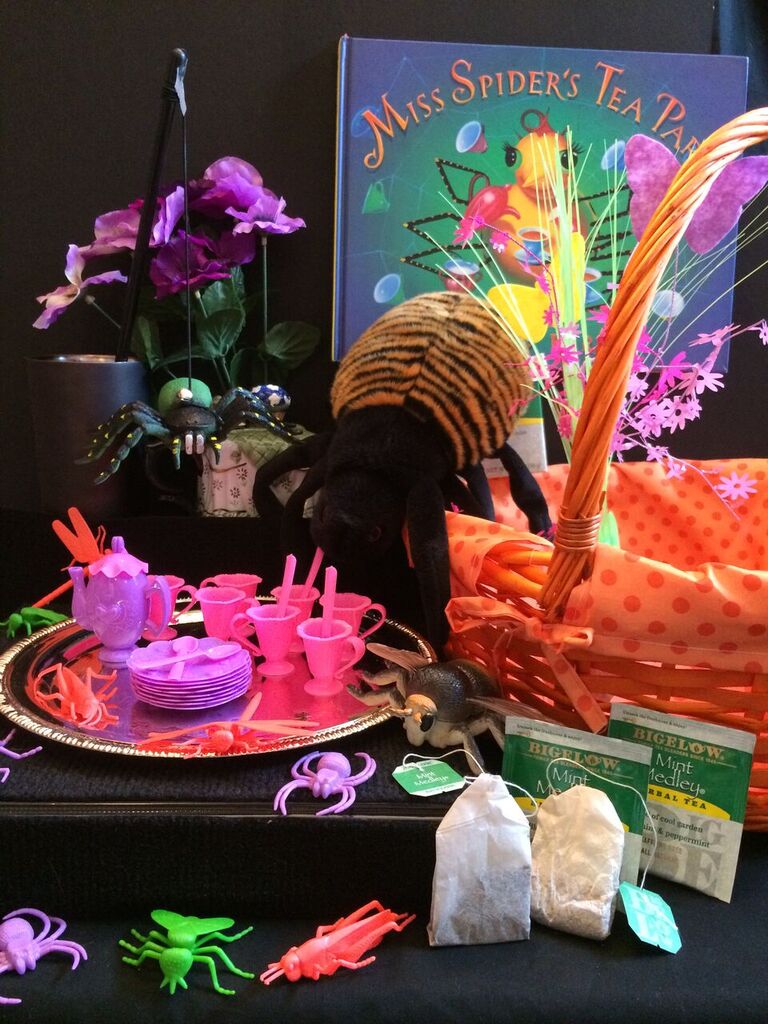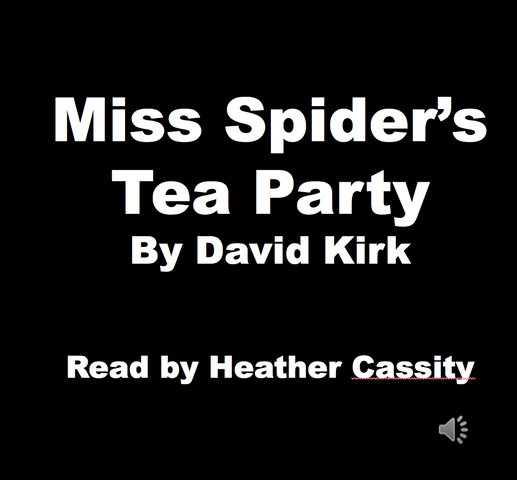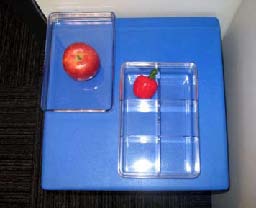As part of the graduate coursework for Visual Impairments and Multiple Disabilities in the Teacher Preparation Program in Visual Impairments at the University of Kentucky, students were asked to complete four projects: Story Box, Picture Communication Symbols for Story Box, Tactile Communication Symbols, and Talking Book Project.
We are sharing them on Paths to Literacy and hope that others will use them! Please add your comments at the bottom of the page.
Story Box
For my story box, I chose to use the book “Miss Spider’s Tea Party” by David Kirk. This book has beautiful, bright graphics that would appeal to low vision students as well as rich language that keeps the young reader engaged. It uses rhyme to create an appealing flow to the story. This book lends itself to a creative selection of items to accompany the story and to create a more interactive experience with the text. The items that I chose can not only be used in direct correspondence with activities and characters in the story, but can also be used to teach other concepts.
Materials
The tactile objects that I chose for the story box are as follows:
- A weighted, stuffed spider (representing Miss Spider)
- A bouquet of butterflies/flowers (“hidden 7 butterflies within a bouquet of flowers”)
- A real teapot (for Miss Spider to brew her tea)
- Miniature play tea set (teapot, teacups, plates, spoons)
- Rubber bugs (to represent the fake insects in the story)
- A dangling spider (to demonstrate a spider’s dissention from her web)
- A silver tray (for Miss Spider to carry her tea set on)
- A toy bumblebee (to represent the bumblebees in the story)
- A bouquet of silk violets (Miss Spider’s preferred diet)
- A butterfly headband (to add whimsy to the experience)
- Miscellaneous plastic bugs (to represent the various insects in the story)
- Actual peppermint tea bags (Beverage served at Miss Spider’s Tea party)
Procedure
- These objects can be used for students to sequence activities in the story.
- Ask “Who did Miss Spider first invite to have tea with her? Did they stay? Why?”
- Students could use the weighted spider as a sensory tool while reading the book.
- The tea party set could be used to show a student how to set a table.
- Discuss party etiquette.
- Count the plates, spoons, and cups.
- Discuss how many guests we could have at our tea party based on that number.
- Students might not have the background knowledge to understand what a party is. Discuss why and how you would go about inviting guests. Discuss how you would have to organize your supplies and plan the details.
- The dangling spider could be used to discuss how a spider descends (vocabulary opportunity) from heights on the silk of her web.
- Discuss how seeing a spider floating down upon them might make the bugs feel. We could discuss how the bugs’ reactions made Miss Spider feel.
- Discuss scientific concepts of insects including their dietary preferences, their hunting habits, their anatomy, their habitats, etc. Young students might not have any background knowledge of such information so this would be the perfect opportunity to expose them to some basic scientific facts.
Picture Communication Symbols for Story Box
In order to give students with low vision or CVI access to communication during my story box activity for “Miss Spider’s Tea Party,” I’ve created 10 picture communication symbols. Using Boardmaker, I’ve put together 10 symbols that would enhance the story telling experience for my students. The buttons are 4 inches by 4 inches. I put a thick black border on each one and altered the background colors to increase visibility of each symbol within the button. I picked symbols to represent characters, concepts, and important details in the story.
The picture symbols that I chose are as follows:
- Miss Spider (picture of Miss Spider)
- 2 beetles (Ike and May)
- 3 fireflies (the fireflies were scared they would be Miss Spider’s meal)
- 4 bees (they taunted poor Miss Spider because she was “spidery”)
- tea cup (to represent Miss Spider’s hospitality)
- party symbol (this was Miss Spider’s intention-not to eat the bugs as the bugs feared)
- sad face (Miss Spider grew increasingly sad)
- scared face (the insects were all scared that Miss Spider wanted to eat them)
- moth (after Miss Spider helped the moth, he spread the word among the insects that Miss Spider was kind and wouldn’t eat them)
- flower (the food of choice for Miss Spider, which made everyone happy).
When using these symbols, I would first show the students the book. I would give them some time to explore the book, flip through the pages and look at the pictures. I would then present the symbols. We would talk about what each symbol might represent. Students would be encouraged to ask questions about the symbols. We could make predictions of how these symbols might be used in the story. With the symbols displayed, I would then read the story. After reading through the story, the symbols could be used to assess comprehension. They could be used to assess an understanding of vocabulary and concepts. Discussion could take place to gauge students’ background knowledge and to dispel misconceptions as well as present facts. Minimal background knowledge would be required for students to be able to enjoy the story and be actively engaged. It would help if students understood concepts such as happy, sad, and scared.
Below is a list of possible questions that could be used along with the picture communication symbols:
- Who is the main character of this story? (Miss Spider)
- Which picture shows Ike and May? (2 beetles)
- Which insects hurt Miss Spider’s feelings? (symbols of 2 beetles, 3 fireflies, or 4 bees)
- What did Miss Spider want to serve the insects at her party? (tea)
- How did the bugs feel when Miss Spider tried to talk to them? (scared)
- How did Miss Spider feel when the bugs kept running away from her? (sad)
- Who was the first friend that Miss Spider made? (moth)
- Who did the moth tell about how nice Miss Spider had been to him? (2 beetles)
- What did Miss Spider like to eat? (flower, tea)
- The bugs thought Miss Spider wanted to eat them. What did she really want to do with them? (party)
I tried to pick symbols that I thought would be familiar to my students. I would hope this would lead to students making a personal connection with this literacy activity. The level of questioning used to assess comprehension would vary depending on individual student levels. I could present all 10 symbols for students to choose from at once or I could limit choices to just 2 or 3 for each question.
Tactile Communication Symbols
Tactile communications symbols provide our students, both verbal and nonverbal, an opportunity to take an active role in literacy activities. By providing tactile information through the sense of touch, students have an increased chance of drawing meaning from the story rather than just having the story read to them. Exploring these tactile symbols helps develop literacy skills by providing practice and support in tactile exploration and interpretation. Such activities provide opportunities for discussion of vocabulary, concepts, development of hand skills, tactual exploration skills, and cognitive skills.
My tactile symbols go along with the story “Miss Spider’s Tea Party,” by David Kirk. I chose symbols that could be used to assess comprehension as well as to provide an interactive experience with the story. I would first talk about the story and give the students time to explore the objects. We could talk about what each symbol could represent and make predictions of what they might represent in the story. Students would need to have prior knowledge of insects (e.g. how many legs a spider has, what insects eat); types of things you would use for a tea party; when and why you would have a tea party; who and how to invite friends to a party; and concepts like happy and sad and how to tell if someone is happy or sad.
- tea cup (what Miss Spider serves tea from)
- a spider (main character)
- a band-aid (representative of the help Miss Spider provided to moth)
- an insect (other characters)
- a pom-pom (representative of a party or the act of partying with friends)
- a spinner bait blade (to represent rain–why moth got stranded with Miss Spider)
- silk flower (what the insects ate at the party)
- a feather (to represent the action of flying)
- a sad face (how Miss Spider felt when the insects were scared of her)
- a happy face (how Miss Spider felt when the insects came to her tea party)
After reading the story to the students, I could ask students to “Hold up or touch the symbol that shows…….”
- Who was the main character in the story?
- What did Miss Spider do for moth?
- How did Miss Spider feel when the insects kept running away from her?
- What did Miss Spider really want to do with the insects? Or Where did Miss Spider invite all of her new friends?
- The moth was too wet to do what?
- What did the bugs use to drink from at the party? Or What did the bugs use to sip tea from at the party?
- What happened that caused the moth to be unable to fly away? Or What fell from the sky that caused moth’s wings to be too wet to fly away?
- How did spider feel when the bugs came to her party? Or How did the bugs/insects feel when the moth told them that Miss Spider was nice and had helped him?
- What did the insects eat at the party?
- What’s another name for a bug? Besides Miss Spider, show me another character in the story.
Talking Book Project
Some students may prefer to use a talking powerpoint book to read along with the book, while listening to the audio version.
This talking book is based on Miss Spider’s Tea Party by David Kirk.





